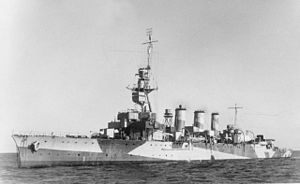 HMAS Adelaide in her third armament configuration
| |
| History | |
|---|---|
| Name | Adelaide |
| Namesake | City of Adelaide |
| Builder | Cockatoo Island Dockyard |
| Laid down | 20 November 1915 |
| Launched | 27 July 1918 |
| Completed | 31 July 1922 |
| Commissioned | 5 August 1922 |
| Decommissioned | 27 June 1928 |
| Recommissioned | 13 March 1939 |
| Decommissioned | 17 May 1939 |
| Recommissioned | 1 September 1939 |
| Decommissioned | 26 February 1945 |
| Recommissioned | 19 May 1945 |
| Decommissioned | 13 May 1946 |
| Motto |
|
| Nickname(s) | HMAS Longdelayed |
| Honours and awards |
|
| Fate | Sold for scrap |
| General characteristics | |
| Class and type | Town-class light cruiser |
| Displacement | 5,560 long tons (5,650 t) |
| Length | 138.8 m (455 ft) |
| Beam | 14.9 m (49 ft) |
| Draught | 5.7 m (19 ft) |
| Propulsion | Parsons turbines, 2 shafts, 25,000 shp (19,000 kW) |
| Speed | 25 knots (46.3 km/h; 28.8 mph) |
| Complement |
|
| Armament |
|
| Armour | 3-inch (7.6 cm) side armour-belt over midships section |
HMAS Adelaide was a Town-class light cruiser of the Royal Australian Navy (RAN), named after Adelaide, the capital city of South Australia. Laid down in 1915, wartime shortages and design modifications meant the ship was not completed until 1922, earning her the nickname "HMAS Longdelayed".
Adelaide served with the Royal Navy's Special Service Squadron during 1924 and 1925, and was involved in the 1927 Malaita massacre. She was decommissioned in 1928, but was modernised and returned to service just before World War II began. During the war, Adelaide was involved in successful efforts to secure the colony of New Caledonia for Free France, was present during the Japanese midget submarine attack on Sydney Harbour, and intercepted the German blockade runner Ramses.
The cruiser was decommissioned in 1946, and broken up for scrap in 1949.